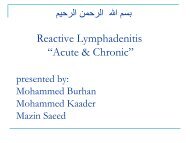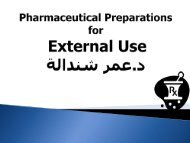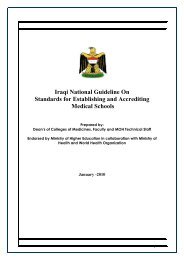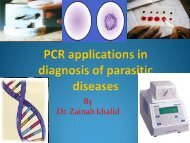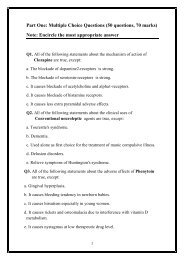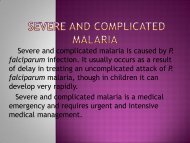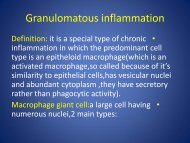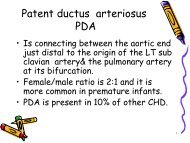New insights into the management of severe sepsis and septic shock
New insights into the management of severe sepsis and septic shock
New insights into the management of severe sepsis and septic shock
- No tags were found...
You also want an ePaper? Increase the reach of your titles
YUMPU automatically turns print PDFs into web optimized ePapers that Google loves.
Surviving Sepsis Campaign UpdatedGuidelines for 2012
Surviving Sepsis Campaign Surviving Sepsis Campaign—a collaboration <strong>of</strong><strong>the</strong> European Society <strong>of</strong> Intensive CareMedicine (ESICM), <strong>the</strong> International SepsisForum (ISF), <strong>and</strong> <strong>the</strong> Society <strong>of</strong> Critical CareMedicine In 2012, it has published an updated version <strong>of</strong><strong>the</strong> International Guidelines for Management<strong>of</strong> Severe Sepsis <strong>and</strong> Septic Shock originallypublished in 2004 <strong>and</strong> last updated in 2008
Guide to Recommendations’ Strengths <strong>and</strong>Supporting Evidence 1 = strong recommendation; 2 = weak recommendation or suggestion; A = good evidence from r<strong>and</strong>omized trials; B = moderate strength evidence from smallr<strong>and</strong>omized trial(s) or multiple goodobservational trials; C = weak or absent evidence, mostly drivenby consensus opinion
DefinitionSepsis is defined as <strong>the</strong> presence (or presumed presence) <strong>of</strong>an infection accompanied by evidence <strong>of</strong> systemicinflammatory response syndrome (SIRS).SIRS is defined as <strong>the</strong> presence <strong>of</strong> 2 or more <strong>of</strong> <strong>the</strong> following:(1) temperature greater than 38°C (100.4°F) or less than36°C (96.8°F)(2) pulse rate greater than 90 beats/min(3) respiratory rate greater than 20 breaths/min (or PaCO2less than 32 mmHg)(4) WBC count greater than 12,000/mm3 or less than4,000/mm3, or greater than 10% immature b<strong>and</strong> forms.
Definitions Severe <strong>sepsis</strong> is defined as <strong>the</strong>presence <strong>of</strong> <strong>sepsis</strong> <strong>and</strong> early org<strong>and</strong>ysfunction or hypoperfusion withlactic acidosis. Septic <strong>shock</strong> is defined as <strong>the</strong>presence <strong>of</strong> <strong>sepsis</strong> <strong>and</strong> refractoryhypotension
Incidence <strong>of</strong> <strong>sepsis</strong> Sepsis is <strong>the</strong> 10th leading cause <strong>of</strong> death in<strong>the</strong> United States overall Sepsis is <strong>the</strong> leading causes <strong>of</strong> admission tointensive care units (around 50%) The annualized incidence <strong>of</strong> <strong>sepsis</strong> isincreasing by 8%. The incidence <strong>of</strong> <strong>severe</strong><strong>sepsis</strong> is increasing greatest in older adults<strong>and</strong> <strong>the</strong> nonwhite population
Prognosis More than half <strong>of</strong> all <strong>septic</strong> patientsdevelop <strong>severe</strong> <strong>sepsis</strong> <strong>and</strong> a quarterdevelop <strong>septic</strong> <strong>shock</strong>; thus, 10% to 15%<strong>of</strong> all patients admitted to ICUs develop<strong>septic</strong> <strong>shock</strong> Published mortality rates for <strong>sepsis</strong> rangefrom 28% to 56%
Management <strong>of</strong> <strong>sepsis</strong> Early haemodynamic resuscitation (earlygoal-directed <strong>the</strong>rapy “EGDT” (resuscitationbundle RB)) Antimicrobial <strong>the</strong>rapy Source control Low tidal volume mechanical ventilation Role <strong>of</strong> steroids? Drotrecogin alfa??
Early haemodynamic optimization(resuscitation bundle) In 2001, a trial <strong>of</strong> early hemodynamicresuscitation to normal physiologicparameters, or early goal-directed <strong>the</strong>rapy,was conducted in ED patients with <strong>severe</strong><strong>sepsis</strong>/<strong>septic</strong> <strong>shock</strong> <strong>and</strong> revealed asignificant mortality reduction. Early goal-directed <strong>the</strong>rapy is an algorithmicapproach to hemodynamic optimization <strong>and</strong>resolution <strong>of</strong> global tissue hypoxia within<strong>the</strong> first 6 hours <strong>of</strong> disease presentation
Early haemodynamic optimization(resuscitation bundle)Specifically, patients are treated by(1) fluid resuscitation with ei<strong>the</strong>r crystalloid or colloid toachieve a central venous pressure goal <strong>of</strong> 8 to 12 mmHg,(2) vasoactive agents to achieve a mean arterial pressuregoal <strong>of</strong> 65 to 90 mm Hg(3) blood transfusion to a hematocrit level greater than30%,(4) inotrope <strong>the</strong>rapy(5) intubation, sedation, <strong>and</strong> paralysisas necessary to achieve a ScvO2 <strong>of</strong> greater than 70%
Early haemodynamic optimization(resuscitation bundle) During <strong>the</strong> first 6 hours in <strong>the</strong> ED, <strong>the</strong> earlygoal-directed <strong>the</strong>rapy group had significantlygreater amount <strong>of</strong> fluid <strong>the</strong>rapy than <strong>the</strong>control group (5.0 versus 3.5 L, respectively),RBC transfusion (64.1% versus 18.5%,respectively), <strong>and</strong> inotrope (ie, dobutamine)administration (13.7% versus 0.8%,respectively). The primary outcome variable, inhospitalmortality rate, was 46.5% in <strong>the</strong> control groupversus 30.5% in <strong>the</strong> early goal-directed <strong>the</strong>rapygroup
Early haemodynamic optimization(resuscitation bundle)Subsequent studies over one decade Validated <strong>the</strong> RB <strong>and</strong> its elements Provided evidence that this <strong>the</strong>rapy modulatesinflammation <strong>and</strong> decrease organ failureprogression Showed that this approach consistently saves 1out <strong>of</strong> every 6 lives presenting with <strong>severe</strong><strong>sepsis</strong>/<strong>septic</strong> <strong>shock</strong>Current guidelines continue to recommend EGDTpending <strong>the</strong> results <strong>of</strong> numerous ongoing trials
Components <strong>of</strong> EGDT(resuscitation bundle) Haemodynamic monitoring Volume <strong>the</strong>rapy Vasoactive agents Increasing oxygen carrying capacity Inotropic <strong>the</strong>rapy Decreasing oxygen consumption
Haemodynamic monitoring Optimal titration <strong>of</strong> fluids <strong>and</strong> vasoactive<strong>the</strong>rapy is performed more objectivelywith invasive monitoring Central venous access allowsmeasurement <strong>of</strong> central venous pressure<strong>and</strong> ScvO
Surviving Sepsis: <strong>New</strong> monitoringrecommendations Using normalization <strong>of</strong> lactate levels as analternate goal in EGDT for <strong>severe</strong> <strong>sepsis</strong>, if centralvenous oxygenation monitoring is not available(Grade 2C). For patients at risk for fungal infection as a sourcefor <strong>severe</strong> <strong>sepsis</strong>, checking one <strong>of</strong> <strong>the</strong> newer assaysfor invasive c<strong>and</strong>idiasis such as 1,3-beta-D-glucan,mannan, or anti-mannan ELISA antibody testing(Grade 2B/C). When no infection can be found, consider using alow procalcitonin level as a supportive tool for <strong>the</strong>decision to stop antibiotics (Grade 2C).
Volume <strong>the</strong>rapy The first parameter to target in hemodynamicoptimization is intravascular volume with <strong>the</strong>use <strong>of</strong> fluid <strong>the</strong>rapy targeting a central venouspressure <strong>of</strong> 8 to 12 mm Hg. No outcome benefit has been demonstrated inusing colloids compared to crystalloids withrespect to mortality or hospital length <strong>of</strong> stay. However, in one investigation a trend toimproved survival with <strong>the</strong> use <strong>of</strong> colloid(albumin) in <strong>sepsis</strong> was observed
Surviving Sepsis: <strong>New</strong> Fluid ResuscitationRecommendations They gave a strong 1A recommendation for <strong>the</strong>use <strong>of</strong> crystalloids like normal saline as <strong>the</strong> initialfluid resuscitation for people with <strong>severe</strong> <strong>sepsis</strong> Incremental fluid boluses should be continued aslong as patients continue to improvehaemodynamically (Grade 1C). They weakly recommended adding albumin toinitial fluid resuscitation with crystalloid for <strong>severe</strong><strong>sepsis</strong> <strong>and</strong> <strong>septic</strong> <strong>shock</strong> (Grade 2B).
Vasoactive agents Vasopressors should be administered whenhypotension is persistent or mean arterial bloodpressure less than 65 mm Hg, regardless <strong>of</strong> <strong>the</strong>central venous pressure, because in <strong>the</strong> presence<strong>of</strong> hypotension, organ perfusion cannot bemaintained with fluids alone. Norepinephrine may be more effective incorrecting hypotension in <strong>septic</strong> <strong>shock</strong> whileavoiding <strong>the</strong> potential tachycardia induced bydopamine In <strong>the</strong> patient with refractory hypotension,vasopressin deficiency should be considered
Surviving Sepsis: <strong>New</strong> Recommendationsfor Vasopressors Authors strongly recommend norepinephrineas <strong>the</strong> first choice for vasopressor <strong>the</strong>rapy(Grade 1B). Vasopressin 0.03 units / minute isan alternative to norepinephrine, or may beadded to it (Grade 2A). When a second agent is needed, epinephrine is<strong>the</strong>ir weakly-recommended vasopressor choice(Grade 2B). Dopamine was only recommended in highlyselected patients whose risk for arrhythmiaswas felt to be very low <strong>and</strong> who had a lowheart rate <strong>and</strong>/or cardiac output (Grade 2C).
Increasing Oxygen Carrying Capacity After mean arterial pressure has beenoptimized, patients with inadequate oxygendelivery reflected by ScvO2 less than 70%,elevated lactate, <strong>and</strong> hematocrit less than30% should receive a transfusion <strong>of</strong> packedRBCs to achieve a hematocrit level greaterthan 30%.
Inotropic <strong>the</strong>rapy After adequate volume, mean arterial pressure,<strong>and</strong> hematocrit goals are met <strong>and</strong> ScvO2 ispersistently less than 70%, dobutamine toimprove contractility, in a dosage <strong>of</strong> 2.5 to 20µg/kg/minute, titrated to achieve ScvO2greater than 70%, is recommended. Because <strong>the</strong> vasodilatory effect <strong>of</strong> dobutaminecould worsen hypotension, it should be used incombination with vasopressors for patientswith persistent hypotension.
Surviving Sepsis: <strong>New</strong> Recommendationsfor inotropic <strong>the</strong>rapy Dobutamine is strongly recommended (byitself or in addition to a vasopressor) forpatients with:1. cardiac dysfunction as evidenced by highfilling pressures <strong>and</strong> low cardiac output, or2. clinical signs <strong>of</strong> hypoperfusion afterachievement <strong>of</strong> restoration <strong>of</strong> bloodpressure with effective volumeresuscitation (Grade 1C).
Decreasing oxygen consumption When ScvO2 remain less than 70% after <strong>the</strong>CVP, arterial BP <strong>and</strong> haematocrit havereached <strong>the</strong> target, oxygen consumptioncan be reduced through mechanicalventilation to decrease <strong>the</strong> work <strong>of</strong>breathing <strong>and</strong> redistribute blood flow tovital organs
Antimicrobial <strong>the</strong>rapy Administration <strong>of</strong> antibiotics within <strong>the</strong> time<strong>of</strong> ED care <strong>and</strong> as soon as possible once<strong>the</strong>re is a reasonable suspicion <strong>of</strong> <strong>severe</strong><strong>sepsis</strong> is likely to increase <strong>the</strong> chance <strong>of</strong>favourable outcome compared with lateradministration (Grade E) Empirical regimens should be sufficientlybroad, so <strong>the</strong>re is little chance (less than5%) that <strong>the</strong> <strong>of</strong>fending pathogen will not beeffectively covered
Empirical antibiotic combinations Pneumonia: a respiratory quinolone(lev<strong>of</strong>loxacin) plus vancomycin (or linezolid) Bacterial meningitis: ceftriaxone orcefotaxime plus vancomycin Urinary tract infections: β-lactam/βlactamaseinhibitor with antipseudomonasactivity (piperacillin/tazobactam) plus anaminoglycoside
Empirical antibiotic combinations Intabdominal infections:piperacillin/tazobactam (or a carbopenem)plus an aminogycoside Skin <strong>and</strong> s<strong>of</strong>t tissue infection: clindamycinplus vancomycin (or linezolid) Unknown source: meropenem (orpiperacilline/tazobactam) plus anaminoglycoside (gentamicine)
Source controlMeasures to eradicate <strong>the</strong> source <strong>of</strong> <strong>the</strong>infection is an integral component <strong>of</strong> <strong>the</strong>rapy.This may include: Abscess drainage Debridement <strong>of</strong> devitalized infected tissue Removal <strong>of</strong> infected pros<strong>the</strong>sis
Drotrecogin alfa (activated protein C) In 2001, <strong>the</strong> FDA approved DrotAA for adultpatients with <strong>severe</strong> <strong>sepsis</strong> <strong>and</strong> a high risk <strong>of</strong>death based on a subgroup analysis from<strong>the</strong> Prospective Recombinant HumanActivated Protein C Worldwide Evaluation inSevere Sepsis (PROWESS) trial. Subsequent studies failed to show anefficacy benefit in patients with low diseaseseverity—or even in patients with a highmortality risk
Drotrecogin alfa (activated protein C) With similar concerns <strong>and</strong> sufficient doubt arisingoverseas, <strong>the</strong> European Medicines Agency calledfor a new trial to investigate whe<strong>the</strong>r DrotAAwould reduce mortality in patients with <strong>septic</strong><strong>shock</strong> PROWESS-SHOCK—a r<strong>and</strong>omized, double-blind,placebo-controlled, multicenter trial <strong>of</strong> 1,697patients The researchers found no significant difference inefficacy between patients who received DrotAA<strong>and</strong> those who did not receive treatment. At 28days, 26.4% <strong>of</strong> patients in <strong>the</strong> treatment arm <strong>and</strong>24.2% <strong>of</strong> patients in <strong>the</strong> placebo arm had died.
Drotrecogin alfa (activated protein C) These results, which prompted <strong>the</strong> removal <strong>of</strong><strong>the</strong> drug from <strong>the</strong> market in October 2011,<strong>of</strong>fer answers to questions about <strong>the</strong> use <strong>of</strong>DrotAA in <strong>severe</strong> <strong>sepsis</strong> that have persistedsince its 2001 FDA approval It might very well be that with earlyantimicrobial <strong>the</strong>rapies, source control, <strong>and</strong>resuscitation, we interrupt <strong>the</strong> <strong>sepsis</strong> response<strong>and</strong> <strong>the</strong> coagulation abnormalities that follow,so <strong>the</strong>re’s no longer a need for this drug
Systemic corticosteroids Despite more than 5 decades <strong>of</strong> study<strong>and</strong> debate, <strong>the</strong> role <strong>of</strong> corticosteroidtreatment in patients with <strong>severe</strong> <strong>sepsis</strong><strong>and</strong> <strong>septic</strong> <strong>shock</strong> remains controversial
Systemic corticosteroids Annane’s practice-changing study published in 2002showed that among 300 <strong>septic</strong> <strong>shock</strong> patients, thosewith a negative cosyntropin stimulation test (“nonresponders”)r<strong>and</strong>omized to 50 mg hydrocortisone IV q6 hours had significantly improved 28-day mortalitycompared to placebo (53% vs. 68%). CORTICUS (2008) <strong>the</strong>n swung <strong>the</strong> pendulum back byshowing no 28-day mortality benefit <strong>of</strong> steroids in 499<strong>septic</strong> <strong>shock</strong> patients (39% vs. 36%) who were nonrespondersto cosyntropin. Steroids did reduce <strong>the</strong>time spent in <strong>shock</strong> (3.3 vs. 5.8 days), but steroidtreatedpatients had more superinfections <strong>and</strong> newepisodes <strong>of</strong> <strong>sepsis</strong>
Systemic corticosteroidsSumming up, corticosteroids do improveblood pressure, but any beneficial effectson survival from <strong>septic</strong> <strong>shock</strong> remain hotlydebated
Surviving Sepsis guidelines regardingcorticosteroid <strong>the</strong>rapy in <strong>severe</strong> <strong>sepsis</strong>Unchanged from 2008, <strong>and</strong> continue to recommend: Hydrocortisone 300 mg / day or less in patients with<strong>septic</strong> <strong>shock</strong> “only after it has been confirmed that<strong>the</strong>ir blood pressure is poorly responsive to fluidresuscitation <strong>and</strong> vasopressor <strong>the</strong>rapy.” (Grade 2C:weak recommendation, low quality evidence) No benefit <strong>of</strong> continuous vs. bolus infusions has beendemonstrated Adding fludrocortisone to hydrocortisone is associatedwith a higher infection rate, <strong>and</strong> shouldn’t benecessary as hydrocortisone has mineralocorticoidactivity. Surviving Sepsis calls fludrocortisone anoptional adjunctive treatment to hydrocortisone.
Surviving Sepsis guidelines regardingcorticosteroid <strong>the</strong>rapy in <strong>severe</strong> <strong>sepsis</strong> Give hydrocortisone for 7 days, <strong>the</strong>nwean it to prevent rebound hypotension<strong>and</strong> blood glucose lability. Stick with <strong>the</strong> 300 mg / day dose: givinghigh-dose corticosteroids to people in<strong>septic</strong> <strong>shock</strong> is known to be harmful.






